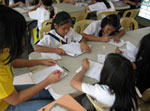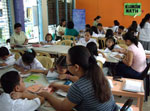Kumon Math Description Of Study Levels
In Level 4A, students learn to write numbers up to 120 independently. Students also work with patterns of up to 20 dots. By learning to recognize the number of dots in a group without counting, students become better prepared for the addition exercises in later levels. By the end of the Level, students learn to count up to 220. All new Grade 1 entrants at Libis Elementary School are slotted at this level.
Building on a strong sense of number sequencing from Level 4A, students are introduced to addition in Level 3A. At first, the students master +1, +2, through to +5 individually. The last 20 sheets of this Level are dedicated to random addition questions from +1 to 5.
In Level 2A, students learn to add through to +1– automatically. This is also the Level where they learn subtraction, subtracting up to –9 by the end. It is very important that students master the contents of this Level for smooth progress in subsequent levels. Level 2A greatly develops a student’s speed and concentration.
Level A continues horizontal addition and subtracton but with larger numbers than in Level 2A. This important level develops the mental calculation ability of students. By the end of it, students will be able to add advanced questions like +200 and subtract from numbers as big as 20.

Level B teaches vertical addition and subtraction. Throughout it, students will encounter their first word problems in Kumon. This Level draws on the advanced mental calculation skills learned in previous levels when students “carry” in addition questions and “borrow” in questions involving subtraction. Mastery of Level B greatly reduces errors in multiplication and division in Levels C and D.
In Level C, students master the multiplication tables by practicing until they can answer immediately. Next, students learn up to 4-digit by 1-digit multiplication with mental carryovers. Once multiplication is mastered, simple division by one digit is introduce. Students who have developed good mental calculation ability will not have to write division steps.
 In Level D, students learn double digit multiplication before advancing to long division. In this challenging section, students develop estimation skills that will be necessary for future fraction work. Once students’ ability to work with all 4 arithmetic operations is confirmed, they begin to study fractions, learning to reduce using the Greatest Common Factor (GCF).
In Level D, students learn double digit multiplication before advancing to long division. In this challenging section, students develop estimation skills that will be necessary for future fraction work. Once students’ ability to work with all 4 arithmetic operations is confirmed, they begin to study fractions, learning to reduce using the Greatest Common Factor (GCF).
Level E drills students on adding, subtracting, multiplying, and dividing fractions. Proper intermediate steps are emphasized. At the end of the level, students learn basic fraction/decimal conversions.
 In Level F, students continue calculations with fractions, now employing the order of operations. Level F contains a challenging section of word problems, as well as more work with decimals. Grade 6 students who reach this level qualify for Bronze status.
In Level F, students continue calculations with fractions, now employing the order of operations. Level F contains a challenging section of word problems, as well as more work with decimals. Grade 6 students who reach this level qualify for Bronze status.
Level G introduces students to positive and negative numbers, as well as to basic algebra. Students use their previously learned four operations skills to master linear equations. A word problem set rounds off the level, allowing students to apply everything they have learned in Level G. Grade 6 students who reach this level qualify for Silver status.
In Level H, students will learn to solve simultaneous linear equations in two to four variables. Concepts of numerical and algebraic values are strengthened. Students are introduced to transforming equations, inequalities, functions and graphs.
